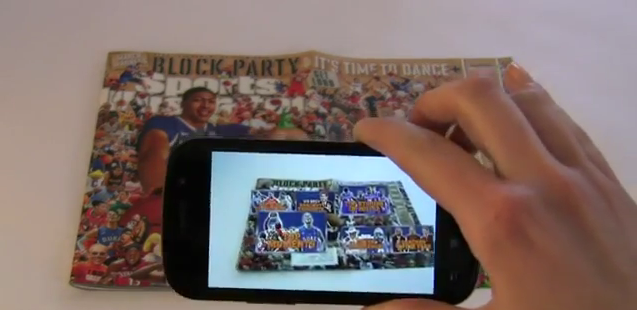Connect with execs from The New York Times, TIME, Dotdash Meredith and many more

QR codes are, for lack of a better term, terrible. Or, put more kindly, they’re a good idea usually terribly executed. Publishers often use them as a shortcut to making their static media “interactive.” This also more often than not falls short with a poor consumer experience and low response rates.
QR codes were a great way for people to get introduced into the concept of print-to-mobile. Now publishers are taking the concept a step further by using QR-like technology to bridge the physical-digital divide. Sports Illustrated, Lucky Magazine and Brides Magazine each are using some kind of digital watermarking, image recognition or companion app to bolster the mobile-reading experience.
Sports Illustrated, for example, sees companion viewing as a positive way to engage its audience and bolster the reading experience to ultimately make a magazine more valuable to readers and brands, alike. The sports magazine created the SI app where one of the options is to scan the magazine cover — this was done with its cover of its March Madness issue — and the scanner will recognize the cover of the issue just from images of the cover and trigger an augmented reality experience.
Working with Nellymoser, SI worked to superimpose 3D buttons on the cover that people can push to launch various videos which were not available, obviously, on the printed issue (nor anywhere else). The unique video content is only available through the image recognition part of the SI app. If you’re a subscriber to the magazine, you get full access to the app for free, adding value to the subscription. If you’re not a subscriber, then they encourage you to subscribe so you can get additional content and capabilities. (You can watch what this looks like here.)
“By the end of year, that will be a major way in which people are using codes; that companion apps will work with different types of codes — watermarkers, image recognition, QR code — so the app becomes agnostic,” said Roger Matus, evp at Nellymoser, a mobile marketing and technology company.
He sees magazines investing in apps with scanners built into them so it becomes more of the magazine experience. So instead of launching a QR app, you’ll launch a magazine-branded app. There is a downside to this, of course. One of the knocks on QR is that it requires an app to scan the code, an extra step that narrows the potential user base. It seems a tall task for each publication to expect its readers to download yet another app. What’s more, why not just give them the content from the app rather than require a scan?
There is the danger that publishers will see these new types of scanning technology, like QR, as a defensive play to guard the erosion of their legacy media assets. There’s the irony, of course, of using new digital technology to defend legacy media from digital’s incursion.
“If publishers are looking at QR codes as a savior or strategy to build around, I think it’s the wrong way to think about it,” said Dave Marsey, group media director at Digitas.
More in Media

Retail media meets publishing: News UK, Future and Ocado tap clean room tech for smarter data targeting
News UK, The Independent, Immediate Media and Future are teaming up with retail media network Ocado to test clean room-powered data matching.

From sidelines to spotlight: Esports events are putting creators center stage
Esports events’ embrace of content creators reflects advertisers’ changing priorities across both gaming and the wider culture. In the past, marketers viewed esports as one of the best ways to reach gamers. In 2025, brands are instead prioritizing creators in their outreach to audiences across demographics and interest areas, including gaming.

Condé Nast and Hearst strike Amazon AI licensing deals for Rufus
Condé Nast and Hearst have joined the New York Times in signing a licensing deal with Amazon for its AI-powered shopping assistant Rufus.





